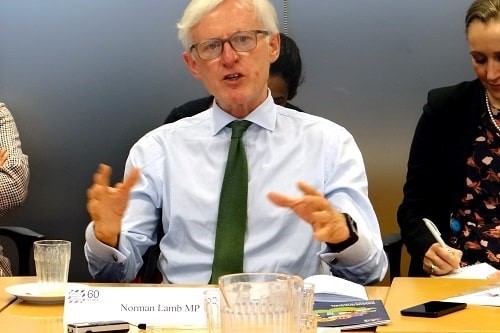The British Safety Council brought together workplace wellbeing experts to review wellbeing concepts and practice.
Features
Redefining workplace wellbeing
Wellbeing is fast becoming a key boardroom issue. However, research by the British Safety Council has identified a lot of uncertainty about wellbeing at work. Its report, Not just free fruit: wellbeing at work, found that employee wellbeing is often ignored or misunderstood. Employers are unsure how to define it, how to improve it, what priority to assign to it and how to measure the success of wellbeing programmes and interventions.
To help organisations solve some of these key wellbeing dilemmas, the British Safety Council hosted a roundtable debate on 20 March. Some of Britain’s most eminent wellbeing thought leaders and passionate campaigners took part in the discussion, chaired by Peter McGettrick, trustee of the British Safety Council and hosted by Lawrence Waterman, its chairman.
The panel included: Professor Dame Carol Black, Professor Sir Cary Cooper, Norman Lamb MP, Charles Alberts, head of Health Management at Aon, Peter Brown, deputy director of the Health and Work Programme at HSE, Dr Shaun Davis, global director of Safety, Health, Wellbeing and Sustainability at Royal Mail, Steve Hails, director of Health, Safety and Wellbeing at Tideway, James Murray, managing director at Vitality and Hugh Robertson, senior policy officer at TUC.
They reviewed and challenged concepts and common perceptions of wellbeing at work.
Workplace wellbeing – what it is and what it is not
Carol: At its simplest, workplace wellbeing is a sense of contentment. It consists of physical and mental health and a feeling that you are in a good place when you’re at work. I think it’s hard to have a sense of wellbeing if you experience very poor mental health.
 Carol Black: "Wellbeing is a feeling that you are in a good place when you’re at work"
Carol Black: "Wellbeing is a feeling that you are in a good place when you’re at work"
Peter M (chair): The Vitality study raised some interesting points regarding workplace wellbeing.
James: Yes, there are many components of wellness relating to the workplace, chief among which is leadership. As Carol said, there are many elements that contribute to workplace wellness and a lot can be done to improve it. You can reference that across good and bad performance and see what they’re doing and what makes a difference to the employee. Our studies show that there’s a big difference between the best in class and the poorer performers.
Hugh: I think part of the problem is that the focus of wellbeing or wellness at work is on physical aspects. I think it should be on the relationship between work and people’s physical and mental state. Wellbeing is when people feel useful and have a sense of positive connection with their work. Many wellbeing initiatives deal with things like obesity or alcohol consumption. In fact, wellbeing is when people have a sense of connection with their work. It combines usefulness, purpose and dignity.
 Hugh Roberston: "Wellbeing is when people have a sense of connection with their work"
Hugh Roberston: "Wellbeing is when people have a sense of connection with their work"
Carol: I don’t think anyone sitting around this table thinks that putting out fresh fruit, bicycle schemes
and yoga classes constitutes workplace wellbeing.
Cary: It is an issue of culture, taking into consideration the whole of an organisation. What annoys me more than anything is the mindfulness training at lunch, sushi at your desk and all that sort of garbage. Wellbeing is really a strategic issue and the good news is that more and more companies treat wellbeing as such. They are looking at their line managers, at working hours, flexible working, etc. They are considering the full package.
Shaun: We’ve gone through this at Royal Mail in the context of challenges such as different working patterns, restructures and reorganisations. We reached the point where people buy into our culture and 503-year heritage. Some have been with us for 30 years and they are coming to the end of their career. That loss of sense of purpose is a big deal for them. Wellbeing is supporting them during that transition, either to another role or when they leave the organisation.
I don’t think many organisations have connected wellbeing to these tough areas. Only the most progressive companies understand that wellbeing is a tool to facilitate business transition, support improvement etc.
 Shaun Davis: "It’s about [giving workers] a voice rather than engagement"
Shaun Davis: "It’s about [giving workers] a voice rather than engagement"
Norman: There is an assumption that people at the top of the organisation suffer most stress. However, a well-known Whitehall study [Stress at Work, by the British Academy Policy Centre] proved that actually, it is people at the bottom of organisations, those with no autonomy and control, who suffered the most stress. I think that’s a very important lesson in the context of workplace wellbeing.
Peter M (chair): Does employee engagement play a big part in that
Steve: Absolutely. In the construction industry, it’s a particularly difficult issue. We have a transient workforce and we work on many projects that have labour-only suppliers. We work with individuals who move from project A to project B and, therefore, don’t have an identity as such. Hugh’s point about sense of purpose is extremely valid. We struggle with those that are almost seen as a commodity, because they’re not part of a corporate structure. They don’t have the benefit of the support from a corporate organisation and don’t get the opportunity to engage in the mechanism and the processes of a corporate organisation.
The challenge is: how do you engage your entire supply chain, when it in part consists of sub-suppliers and sub-contractors. In Tideway, we work hard to achieve the right level of engagement with the whole of our workforce. Where we were successful, we achieved it through our teams, rather than via a top-down approach.
Carol: I think it would be worth asking those present about engagement. There may be some of us who don’t buy into engagement as much as Steve.
Cary: I don’t buy into it either.
Carol: I much prefer the idea that people should feel they’re in a purposeful activity. That is what’s driving them, rather than measuring engagement. I think you can push people to be engaged but it doesn’t last.
Cary: Engagement was a good starting point. It was supposed to be the magic bullet that’s going to sort out the UK’s productivity problems. It hasn’t, and you know why? It’s because we put it into a yearly metric. I bet you everybody around this table have yearly engagement measures.
 Cary Cooper: "I prefer the idea that people should feel they’re in a purposeful activity. That is what’s driving them, rather than measuring engagement."
Cary Cooper: "I prefer the idea that people should feel they’re in a purposeful activity. That is what’s driving them, rather than measuring engagement."
James: HR professionals now feel it’s useful, that engagement should be part of what you talked about.
Cary: Engagement is a sense of purpose, getting people in control and giving them autonomy.
Peter M (chair): Isn’t that engagement
Cary: That is engagement, but it’s now measured annually, it’s delegated downwards, and it produces almost no results. It was a good starting mechanism. But I guess Shaun, that’s probably why you’ve decided to dump it?
Shaun: We’re looking at it. However, rather than it just being that incremental 1 per cent, 2 per cent year-on-year, we are trying to determine what does that tell you, looking at the more inclusive voice of the internal customer and the employee experience. It’s more of a narrative than a score.
Peter B: McLaren and Clark’s four principles of engagement suggest looking at an organisation’s culture through four lenses: strategic narrative, the presence of engaging managers, people who could have a conversation, employees with a voice who could make their views felt, and organisational integrity. It is about having a good, positive culture. Engagement is part of it, because if you’ve got those four lenses, you’ve got people who feel valued and they can say what they need to, to managers who are listening. We need more wellbeing literacy and more engagement literacy.
 Lawrence Waterman: "Proper engagement allows workers to participate in fundamental decisions"
Lawrence Waterman: "Proper engagement allows workers to participate in fundamental decisions"
Lawrence: The workers are much more sophisticated than is assumed. They are often treated disrespectfully by senior management as a sales tool for their workers to buy into strategies already adopted. They are like customers who buy a product but they are not involved in any decisions concerning it. Proper engagement allows workers to participate in fundamental decisions instead of just being their ‘happy recipients’.
Shaun: It often happens that engagement questionnaires are ignored; companies are more interested in their engagement scores. It’s about a voice rather than engagement. However, just asking people isn’t giving them a voice because people need to be informed and most of them aren’t. Many people go to work and the last thing they want is their employer to keep on engaging them.
Changing nature of wellbeing
Peter M (chair): Is the definition of wellbeing changing
Shaun: We have been discussing what wellbeing means for a long time but only recently did the conversation begin to include mental health. Financial health, spiritual health and the whole person approach are coming next. As Lawrence pointed out, more people realise that wellbeing includes giving the freedom to make decisions, as well as the tools and information to take them.
I think we are moving on but there is still a lot to do. I am particularly interested in engagement. A friend of mine who works in HR proudly told me that they’d got 100% completion of their employee engagement survey. They put their staff in a room and made them complete it. Is this a true measure of engagement?
Charles: Overall, the approach to wellbeing is now becoming more holistic. Companies are beginning to understand that this is about individuals, how contented they are with their work and life, but also the culture of an organisation.
People are at different stages of wellbeing, come from different backgrounds and have different requirements. This is one of the greatest challenges for employers – how do they cater for the different needs of their workforce?
Steve: I agree with Shaun and Charles, but I wanted to come back to the point that Carol raised. The fact that we’ve got it wrong doesn’t mean that engagement itself is wrong. We set out what the wellbeing programme would look like and it started to fail.
We should have been asking in the first place: what should our wellbeing programme include? That is real engagement. When we heard from the staff that they welcome financial support, we started paying attention to these issues and included them in our wellbeing programme.
James: It’s about culture, it’s about leadership, it’s about getting your employees engaged at a very tactical level. It’s stuff that will make a difference to them and improve their health and wellbeing. I think there’s still a long way to go.
 Charles Albert: "Choice is really important. What appeals to one individual might not suit another"
Charles Albert: "Choice is really important. What appeals to one individual might not suit another"
Peter B: There is a danger in seeing wellbeing as a separate issue rather than an integral part of running a business. It can be seen as an add-on, like corporate social responsibility. We do a bit of this and a bit of that and we’ve ticked that box. Actually, what matters is how you run your business and whether you run it in a way that empowers people and makes them feel happy at work.
James: Which is about leadership and the board having direct input into the health of its workforce. We should be talking about how healthy our workforce is and what we are doing within the constraints of the business to improve it, rather than cherry picking some issues we wish to measure.
Peter M (chair): How to incentivise and support companies to adopt wellbeing practices
Cary: We know what a wellbeing programme should look like but only now are we asking people what it should include. It’s a board-level issue that is affecting the bottom line of the business through sickness, absence rates, presenteeism rates and turnover rates. That’s why we should be measuring what we do and giving that data to the board, to the finance director and the HR department.
James: Some matters relating to wellbeing are ‘soft’ issues, which businesses do not measure well, i.e. poor productivity. If they don’t measure these factors, they don’t believe that there is a problem. Many businesses still believe that presenteeism isn’t an issue in their companies.
Carol: In the second review I did for the government, we found that 140,000 people a year go directly from employment into the benefit system, without ever going through sickness, absence. They are usually middle-aged men in a low-income bracket. They are a great loss to the labour market and we haven’t learned how to deal with them and find them other jobs.
Norman: In the private sector, employers have a statutory duty to make a profit. They concentrate on productivity and sickness absence. For some of them, it is more productive to treat their workforce as a disposable commodity. This is how the gig economy came about. Having said that, we shouldn’t assume that the gig economy is bad for wellbeing. When I get Uber, every time I ask the driver: ‘do you enjoy your job?’, the answer is yes, because they are in control and they decide when they work and they take the children to school. The job fits into their lives.
I chaired a commission on mental health in the West Midlands and we looked at ways of engaging companies with wellbeing. We came up with an idea that you could offer a discount on business rates or on national insurance for a defined period of time. We suggested two years. The deal is that in return for the discount you engage in evidence-based interventions, such as training line managers, that can be effective in improving the experience of people at work.
 Norman Lamb: "Measurement is going to be critical"
Norman Lamb: "Measurement is going to be critical"
We proposed testing different levels of incentives. Measurement is going to be critical if we are to convince the Treasury that this could be effective, and time will tell if we’re able to measure them effectively. The potential benefit of it is that it can work well with SMEs, by giving them a small incentive, you will get people thinking. The idea is that if you can get them doing stuff that we know is effective, then you don’t need to continue a public subsidy for any more than, say, two years. The idea, called a Wellbeing Premium, is now being trialled in the West Midlands with companies that genuinely engage in wellbeing.
Cary: This idea is familiar to me. I’m old enough to have known the Industrial Training Boards, which operated in the construction industry. Perhaps they are still around. ITB were a great idea and they required companies to put money, i.e. 1% of your payroll budget into a pot for future investment. If you wanted to get that money back, you had to provide the training. The idea was to encourage development.
Norman: The apprenticeship levy is based on a similar approach: you pay in, and if you don’t use it, you lose it, but you can choose to use it to employ apprentices.
Cary: I prepared a report with Carol called Mental Capital and Wellbeing for the government Office for Science in which we recommended this approach. We said that it should target the SMEs, which is a really problematic sector. However, it’s vital we engage with it, as the sector employs 60% of the workforce in the private sector.
Norman: In my view, the government should be interested in happiness at work, both for its own sake but also because it ultimately reduces the burden on the NHS. I also think that you could use public sector procurement as a tool. We expect nothing of companies that contract with the state and take taxpayers money, either at a local or a national level.
Shouldn’t we be expecting them to be good employers, respecting their supply chain? There should be a kind of New Deal in public sector procurement. The companies which contract with the government and take money from the public purse should be expected to be good employers and behave in a sustainable way, unlike Carillion.
James: There’s a lot of evidence around the use of incentives, both at a company and employee level, to drive changes in behaviour. For example, just over half a million people worldwide in America, South Africa and the UK changed their behaviour with an incentive system utilising loss aversion behavioural change, by using the Apple watch as an incentive. These are significant changes in activity levels and you can see from a baseline that there’s a 30% increase in activity. The changes in those behaviours have a halo effect: people smoke less, drink less, they sleep better. These are not financially huge investments but just sensible targets.
Peter B: I wonder whether this approach could in some way be applied to the NHS, since the NHS does nothing to encourage people to behave better. We could be offering nudges, on a broader population-wide basis.
Charles: I think employers would find it very useful to receive guidance on how you create the right infrastructure for engagement in wellbeing. We know what we need to do to lead a healthy life, but there are reasons why we don’t do it. What factors will help people make genuine behavioural changes? Choice is really important since we’re different and we’re all at different stages of our wellbeing journey. What appeals to one individual won’t necessarily suit another.
James: We could factor in some liberal paternalism which guides people to the right choice and gives them a reason to make the right choice. You’re not coercing people; you’re giving them the opportunity to make the right decisions. That needs to be understood at a business level. Unfortunately, many organisations that I work with have got a limited budget for wellbeing. They’re too scared to ask questions because they’re afraid of the answers. However, you can inform your wellbeing strategy using data analytics, looking at things like absence data, employee benefits and so on. They will help you understand what the underlying health risks are and how much you need to spend. That’s where the channelling of individuals becomes really important, so if you’re unable to offer everything, how do you as the employer determine what’s going to happen next.
Cary: I think it’s really important to engage the top team personally. It will have an impact. I’ve recently met some CFOs who became interested in workplace wellbeing, particularly when I explained to them how these issues will affect their companies’ bottom line. They’re probably more important to engage than the CEO, as they’re the ones with the buck.
Hugh: Once you start looking at incentives, that’s when you begin moving away from seeing wellbeing just in the context of the bottom line. I think that’s the most important thing about incentives. The question is what kind of things are you incentivising? There’s a huge number of cowboys out there who will go and try to sell a lot of weird things to employers. Incentives have to be evidence-based. Some of these things, for instance screening programmes, replicate what’s available from GPs. They can create problems for the NHS.
I want to add another thought in this context. In the past, most wellbeing initiatives were being done by the employees themselves, via social clubs. They still exist in the railway sector. They were very effective. Therefore, when considering incentives, we should perhaps look beyond employers and allow workers to take ownership of some aspects of wellbeing.
 Steve Hails: "I’m concerned about how we get the data to demonstrate that wellbeing is a worthwhile investment to an organisation"
Steve Hails: "I’m concerned about how we get the data to demonstrate that wellbeing is a worthwhile investment to an organisation"
Norman: I think that we need to engage the government in this and to find ways of getting the message out. There is a role for incentives or a levy, with a levy perhaps working as an incentive. These are companies that are smart enough to realise that you are trying to help them. What about all those companies that can’t do that. There has to be something to engage that mass of employers who don’t instinctively get it. Yet, there is a green paper from Matt Hancock in the wings on prevention – on how to prevent things going wrong.
Carol: There is also a very good framework that has been developed over the last three years with employers both inside and outside the NHS. It contains various toolkits.
Steve: I’d love to see some guidance coming from the government on incentives for workplace wellbeing and how they could work. People in this room work in organisations where we’ve already done some of that legwork and our boards and our exec get it. Therefore, they don’t need to see the evidence of what the benefits are. However, this is not the case in the world outside. I’m concerned about how we get the information, the data to demonstrate that this is a worthwhile investment to an organisation.
If you analyse absence data as an example, you could focus your wellbeing programme on the wrong area. Musculoskeletal disorders are the biggest cause of workplace absence according to our absence data. The actual root causes of that is mental ill health because individuals do not work in an environment in which they feel safe enough to admit that they experience mental ill health.
The wellbeing debate continues in Safety Management's next issue
FEATURES

Sedentary working and how to combat the ‘sitting disease’
By Gavin Bradley, Active Working on 05 April 2024
Prolonged and excessive sitting poses a major risk to our health, but the Get Britain Standing campaign and On Your Feet Britain Day on 25 April are a great way of encouraging workers to sit less and move more.

Company culture and wellbeing: a crucial link
By Bex Moorhouse, Invigorate Spaces on 05 April 2024
Investing in measures to support worker wellbeing will be ineffective unless the company culture genuinely incorporates values like teamwork, involvement, flexibility and innovation.

Office design and culture: happier and healthier staff – or the opposite?
By Guy Osmond, Osmond Ergonomics on 03 April 2024
Applying ergonomic principles to workstation set-ups and ensuring the physical environment supports neurodivergent people are just some of the ways of creating an office where everyone can thrive, but a supportive and positive organisational culture is vital too.


